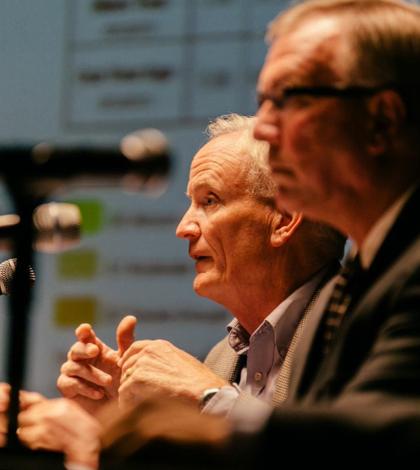Coping with with one of the worst droughts in California history is the main topic of the eighth annual San Bernardino County Water Conference. There are lots of ideas for saving water, but cutting residential use is a popular first target.
San Bernardino County held its eighth annual water conference last month, hosted by the Baldy View Chapter of the Building Industry Association of Southern California.
Maybe the BIA should have called it the drought conference, since the state’s dwindling water supply was the dominant topic during the four-hour session at Cal State San Bernardino.
About 360 people attended the event, a capacity crowd, many of them representatives from cities and water agencies in Riverside and San Bernardino counties.
From the opening session on, speaker after speaker called for stronger conservation measures throughout the state and greater investment in the state’s water infrastructure.
The panel discussions and speaker topics demonstrated the urgency of the drought, which has caused the depletion of 63 trillion gallons of water throughout the western United States, according to a recent Los Angeles Times report.
“Drought, Are We In Or Out?,” “Surviving a Zero Allocation Year,” “Financing Sustainable Water,” “Coordinating Land Use and Water” and “Statewide Issues and the Drought,” were among the topics discussed. Even the vendors in the lobby of the Santos Manuel Student Union Building were emphasizing water conservation: Toro Company, the lawn maintenance corporation whose irrigation division is in Riverside, was demonstrating its water-conserving sprinkler heads.
Officials also called for the passage of a $7.5 billion water bond this November, potentially the largest investment ever in California’s water infrastructure.
That measure would provide approximately $2.7 billion for the building of dams, reservoirs and other water storage projects. Once in place, that infrastructure would help store more water and make it easier for the state to deal with future dry spells.
Gov. Brown, who signed the legislation immediately after it was passed overwhelmingly by the Senate and Assembly, said he’s never seen Democrats and Republicans so united on a single issue.
Whether voters approve the measure, which took several weeks of difficult negotiations to complete, remains to be seen. However, there’s no question that the state’s water system needs a major overhaul.
“The problem is we have a [statewide] water system that was designed for the needs of 1914, not for the needs of today,” said Larry McKenney, general counsel for the Santa Ana Watershed Project Authority in Riverside and part of the panel that discussed statewide water allocation. “We also have a system that is not set up to import water, and that’s a problem in a drought of this magnitude.”
Panelist Robert Craig, board chairman of the Chino Basin Watermaster, said that organization is considering recycling more potable water, similar to what is done with water used in agriculture.
The five agencies that make up part of the Santa Ana Watershed are combining their resources to create some regional projects, including rebates to people who remove their lawns, technology that allows households to compare water use and establishing tiered rates in some communities, McKenney said.
Tiered rates would reward residents who use less water and penalize those who use too much. The watershed’s member agencies, each of which are trying to find better ways to catch storm flows and recharge water basins, have asked for approximately $20 million in grants that would help pay for their proposed projects.
“There are all kinds of things you can do in a drought,” McKenney said. “There are wholesalers who are willing to sell water in a drought, believe it or not. You just have to go out and find them.”
In the short-term, reducing residential water use is probably the best way for the state to save water, said Jeff Sims, assistant general manager of the Western Municipal Water District, an entity that covers 527 square miles between Corona and Temecula.
“I really believe that’s where we’ll get the best results,” Sims said. “If we could cut just residential use by 10 percent, which is a realistic goal, it could save the state 6,000 acre-feet of water a year.”
The Brown Administration has already adopted some severe restrictions on residential water use, which it adopted after its request for voluntary cutbacks meant to cut statewide water use by 20 percent didn’t work.
Those restrictions, which went into effect in late July, include a ban on washing sidewalks and walkways, watering landscapes to runoff – meaning don’t use so much water that it runs off the sidewalk and into the gutter – and using a hose to wash a motor vehicle unless the hose has a shut-off nozzle .
Also, using potable water in a fountain or other decorative feature is prohibited unless the water is recycled.
Violators could be fined up to $500 a day. Felicia Marcus, chairwoman of the State Water Resources Control Board, was quoted as saying that state residents should consider it a “badge of honor” to have a brown lawn and a dirty car, and that everyone in the state should act as if it will never rain here again.
Locally, several Inland Empire cities have adopted water-use restrictions designed to supplement the state regulations.
Earlier this month, La Verne adopted an urgency ordinance that includes all of the state restrictions plus some limits on commercial water use, including a ban on restaurants serving water to customers unless the customer requests it.
In Riverside, the city’s public utility has limited lawn watering to 6 p.m to 10 a.m., restaurants can serve water only when it’s requested and city residents have been asked to cut their water use by 15 percent. Riverside has also stepped up its marketing efforts to tell people how they can save water.
One conference speaker believes retrofitting old houses would go a long way toward easing the state’s water shortage.
Robert Raymer, senior engineer with the California Building Industry Association in Sacramento, wants to replace toilets, faucets and other water fixtures up and down the state, especially in single-family houses built before 1980.
A monumental and expensive task, but doing so will bring older homes closer to the water-saving standards of newer homes, and save the state as much as 300 billion gallons of water a year, according to Raymer.
One of the gloomiest forecasts during the conference came from Bill Patzert, an oceanographer with NASA Jet Propulsion Laboratory.
The current drought began about 16 years ago and could last another 10 years, and the El Nino system that earlier this year looked like it was going to bring rain to Southern California this fall has weakened, Patzert said.
 IE Business Daily Business news for the Inland Empire.
IE Business Daily Business news for the Inland Empire.


